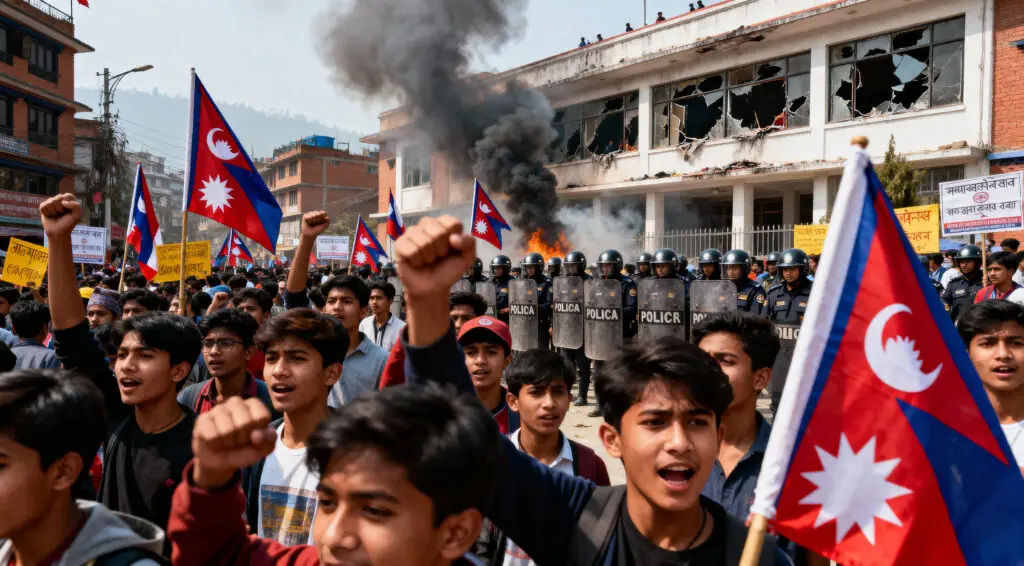Gen Z Uprising Triggers National Political Shockwave
On September 8, 2025, Nepal experienced a youth-led uprising following a government ban on social media. Protesters clashed with police and targeted government buildings, focusing on corruption and nepotism. Police shot at protesters in Kathmandu, killing dozens.
People set fire to government buildings and mocked politicians. The unrest led to Prime Minister K. P. Sharma Oli’s resignation, creating a power vacuum unprecedented in Nepal’s history. The movement grew beyond digital freedom and focused on corruption and nepotism.

Source: CNN
Constitutional Crisis and Interim Leadership Transition
As the protests grew stronger, Nepal’s military stepped in to calm things down and start talks. Talks with Gen Z leaders and political leaders tried to set up a temporary government to bring back order. Former Chief Justice Sushila Karki became a consensus candidate, even though the constitution says that retired judges can’t hold executive positions.
Sushila Karki was officially sworn in as interim prime minister on September 12, 2025. It was the first time a woman had held the highest executive office in Nepal when she was appointed. The constitutional framework held up thanks to presidential support, but legal groups warned that dissolving parliament could hurt democratic principles.
Social Media Bans Ignite Generational Resistance
The government’s choice to block 26 social media sites made a lot of young people very angry. Officials said the ban was a way to keep things in order, but critics saw it as a way for the government to be more authoritarian. These platforms are very important for millions of young Nepalis to make a living, talk to each other, and express themselves.
Students, creators, and workers who depend on digital ecosystems came together to protest. People saw the ban as an attack on their freedom and chances to make money. These restrictions hit home for a generation that grew up online as the world becomes more digitally connected.
Recommended Article: Philippines Flood Control Fraud Sparks Massive Protests
Systemic Frustration Fuels Revolutionary Demands
Nepal’s Gen Z movement started because people were unhappy with how the government had been run for years. Power structures were controlled by political elites from major parties, which silenced young voices and kept corruption going. People who felt left out of political decision-making were clearly frustrated as a result.
High unemployment, rising costs of living, and widespread nepotism made people even more angry. A lot of young activists think that the current political system can’t bring about real change. This uprising is a direct threat to the power networks that have ruled Nepal for decades.
Regional Powers Watch Nepal’s Upheaval Closely
India, China, and the United States are all paying attention to Nepal’s internal problems. All three countries have strategic reasons for wanting Nepal’s politics to stay stable because of cultural, economic, and geopolitical ties. India is still Nepal’s biggest foreign investor, but China is working on Belt and Road projects to gain more power.
The US sees its role as helping others and competing with China in a strategic way. Regional players are keeping a close eye on Nepal’s situation because they know that instability could change the balance of power in South Asia. International responses have been cautiously supportive of the interim government’s efforts to stabilize the country.
Revolutionary Echoes and Historical Parallels
Since the middle of the 20th century, Nepal has gone through a lot of political changes. Democratic and revolutionary movements in the past overthrew authoritarian governments, set up new systems, and helped shape the country’s modern identity. The protests led by Gen Z are similar to these earlier ones, but they have a very digital and generational feel to them.
Nepal’s politics have been shaped by cycles of revolution and counterrevolution throughout history. The current movement brings back calls for social justice and changes to the system. Its broad base, which includes marginalized groups, privileged youth, and civil society, marks a turning point for the country.
Rewiring Governance for a New Generation
The interim government has a lot of work to do to restore stability, rebuild institutions, and get ready for elections. During the protests, more than 300 public buildings were damaged and needed to be rebuilt right away. To stop more unrest, it is very important to rebuild trust between people and institutions.
Nepal’s future will depend on getting Gen Z activists involved and fixing problems like unemployment and inequality. The uprising has made people rethink old political norms and call for changes to the constitution and the way the government works. Nepal is at a crossroads where the hopes of the next generation could change the course of its democracy.























